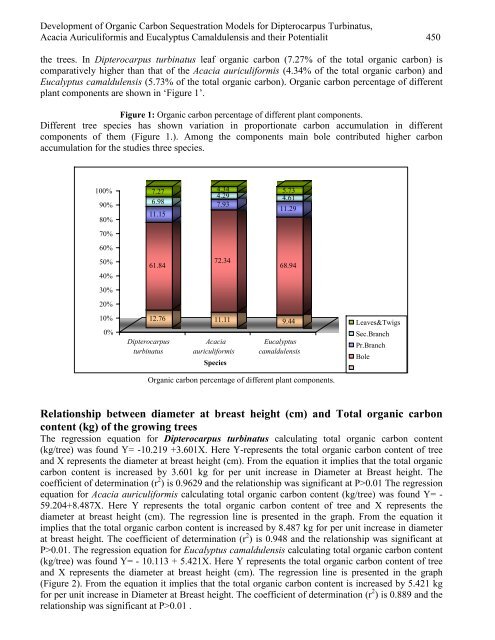European Journal of Scientific Research - EuroJournals
European Journal of Scientific Research - EuroJournals
European Journal of Scientific Research - EuroJournals
Create successful ePaper yourself
Turn your PDF publications into a flip-book with our unique Google optimized e-Paper software.
Development <strong>of</strong> Organic Carbon Sequestration Models for Dipterocarpus Turbinatus,<br />
Acacia Auriculiformis and Eucalyptus Camaldulensis and their Potentialit 450<br />
the trees. In Dipterocarpus turbinatus leaf organic carbon (7.27% <strong>of</strong> the total organic carbon) is<br />
comparatively higher than that <strong>of</strong> the Acacia auriculiformis (4.34% <strong>of</strong> the total organic carbon) and<br />
Eucalyptus camaldulensis (5.73% <strong>of</strong> the total organic carbon). Organic carbon percentage <strong>of</strong> different<br />
plant components are shown in ‘Figure 1’.<br />
Figure 1: Organic carbon percentage <strong>of</strong> different plant components.<br />
Different tree species has shown variation in proportionate carbon accumulation in different<br />
components <strong>of</strong> them (Figure 1.). Among the components main bole contributed higher carbon<br />
accumulation for the studies three species.<br />
100%<br />
90%<br />
80%<br />
70%<br />
60%<br />
50%<br />
40%<br />
30%<br />
20%<br />
10%<br />
0%<br />
7.27<br />
6.98<br />
11.15<br />
61.84<br />
12.76<br />
Dipterocarpus<br />
turbinatus<br />
4.34<br />
4.29<br />
7.93<br />
72.34<br />
11.11<br />
Acacia<br />
auriculiformis<br />
Species<br />
Organic carbon percentage <strong>of</strong> different plant components.<br />
Relationship between diameter at breast height (cm) and Total organic carbon<br />
content (kg) <strong>of</strong> the growing trees<br />
The regression equation for Dipterocarpus turbinatus calculating total organic carbon content<br />
(kg/tree) was found Y= -10.219 +3.601X. Here Y-represents the total organic carbon content <strong>of</strong> tree<br />
and X represents the diameter at breast height (cm). From the equation it implies that the total organic<br />
carbon content is increased by 3.601 kg for per unit increase in Diameter at Breast height. The<br />
coefficient <strong>of</strong> determination (r 2 ) is 0.9629 and the relationship was significant at P>0.01 The regression<br />
equation for Acacia auriculiformis calculating total organic carbon content (kg/tree) was found Y= -<br />
59.204+8.487X. Here Y represents the total organic carbon content <strong>of</strong> tree and X represents the<br />
diameter at breast height (cm). The regression line is presented in the graph. From the equation it<br />
implies that the total organic carbon content is increased by 8.487 kg for per unit increase in diameter<br />
at breast height. The coefficient <strong>of</strong> determination (r 2 ) is 0.948 and the relationship was significant at<br />
P>0.01. The regression equation for Eucalyptus camaldulensis calculating total organic carbon content<br />
(kg/tree) was found Y= - 10.113 + 5.421X. Here Y represents the total organic carbon content <strong>of</strong> tree<br />
and X represents the diameter at breast height (cm). The regression line is presented in the graph<br />
(Figure 2). From the equation it implies that the total organic carbon content is increased by 5.421 kg<br />
for per unit increase in Diameter at Breast height. The coefficient <strong>of</strong> determination (r 2 ) is 0.889 and the<br />
relationship was significant at P>0.01 .<br />
5.73<br />
4.61<br />
11.29<br />
68.94<br />
9.44<br />
Eucalyptus<br />
camaldulensis<br />
Leaves&Twigs<br />
Sec.Branch<br />
Pr.Branch<br />
Bole

















